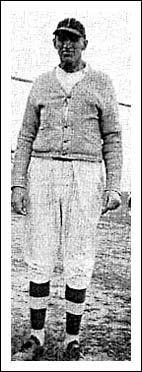
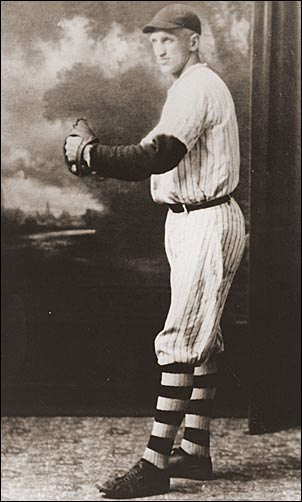
Lester "Slim" Haynes
Right-handed pitcher, Stavely, Alberta
1909-1943. 6'2", 185 lb
[Photo, right, courtesy of the Alberta Sports Hall of Fame]
The Stavley-area farmer was an outstanding pitcher for more than 30 years in Southern Alberta. An erroneous newspaper headline led to even more fame - with an entry in Ripley's Believe It Or Not !
Haynes, then just 22, and his wife May had come to the area in the winter of 1908 from Pullman, Washington.
In a 1968 interview with Washington's Tri-City Herald, Haynes said he couldn't remember just why he left the state, "I'm not really sure why I went to Canada," he said. "I think I was just tired of fighting all that damn Palouse mud."
The newspaper carried a feature on him after his induction into the Alberta Sports Hall of Fame. By this time he was back in Washington living near his daughters in the Kahlotus area (he returned to Washington in 1944 after a big sendoff party in Stavely).
"I pitched five no-hitters. The fast ball was my best pitch and I had a bit of a curve, but, more than anything - and I'm bragging now - I had control. Got to have that. I didn't use the spitter much. I never did know where that one was going." (TRI-CITY HERALD, December 11, 1968)Haynes pitched his first game for Stavely in 1909 after a resident offered to drive his tractor if he would pitch for the local team. He made an early, favourable impression :
STAVELY BEAT CLARESHOLM : In a scheduled game in the Southern Alberta Baseball League played in Claresholm on July 8, Stavely defeated Claresholm by a score of four to seven. Ardell, the ex-Medicine Hat pitcher, received a severe bumping, while Haynes for Stavely pitched masterly ball, only two hits being made off his delivery, and he did not issue a pass. He had the much touted Claresholm batters completely at his mercy, striking out twelve men. Claresholm was lucky to get their four runs as they scored on three errors and two hits. Those were the only errors made by the Stavely team. Claresholm tied the scored in the sixth inning but were never dangerous after that, while Stavely in the first half of the ninth made four hits in a row, scoring three runs. (The Lethbridge Daily Herald, July 10, 1909)
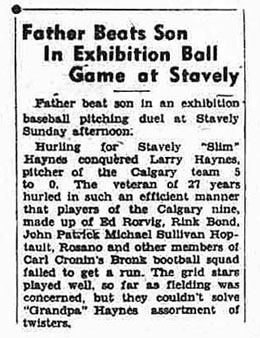

He continued to pitch until 1943 in Canada and even tossed a few innings in 1944 upon his return to Washington. He drew headlines for over 34 years in Alberta, once for a pitching victory over his son. (Clipping from The Albertan, Monday, July 18, 1938)
 Haynes won a prominent spot in Stavely's history with an entry in Butte Stands Guard, the publication of the Stavely and District Historical Society.
Haynes won a prominent spot in Stavely's history with an entry in Butte Stands Guard, the publication of the Stavely and District Historical Society.
[Haynes photo left courtesy of the Glenbow Museum ND-10-140]
Lester "Slim" Haynes and May Moore were married in 1908 and in December of the same year came to Stavely where they purchased a half section of Calgary and Edmonton Railway land north of town.
Before coming to Stavely, Slim was a graduate of Washington State College at Pullman, Washington and while living there had been offered contracts to pitch baseball for both the American and National League baseball clubs.
It was fortunate for Stavely sports fans that he chose to go farming in Alberta for in the spring of 1909, Slim, then 22, started pitching for the Stavely club. That launched his phenomenal baseball career and he soon became known and feared by every batter in the country because of his fast ball, good curve and pinpoint control.
In Stavely "Slim" found a group of young enthusiasts with a desire to play ball and with his coaching, encouragement and leadership they became a winning club which won the Southern Alberta Baseball Championship.
. . . Because of his activities and participation in all sports another honor came to him when, on November 23, 1968 he was inducted into the Alberta Amateur Hall of Fame. Two days later a banquet was held in his honor in the Community Hall, sponsored by the Stavely Elks when a huge crowd assembled from many points in southern Alberta to pay tribute to a distinguished sportsman who had donated so many years of volunteer service to our community.
At this event, which is still remembered as "Haynes Night", Slim was presented with a framed photograph of himself, taken in his heyday as a pitcher with the Stavely team, and also with the guest book signed by 349 people.
May Haynes also took a lively interest in sports and their four children who attended Parkland school and later Washington State University were well known for their sports ability.
In February 1944, Mr. and Mrs. Haynes left our district for Spokane, Washington. In June 1951, May Haynes passed away and Les, at the age of 88, makes his home in Kahlotus, Washington near his daughters, Elizabeth and Doris. Another daughter, Jessie, lives in Bakersfield, California while a son, Laird, a former football and basketball star and a World War II pilot in the R.C.A.F. is now farming in Nebraska. (pages 247-248)
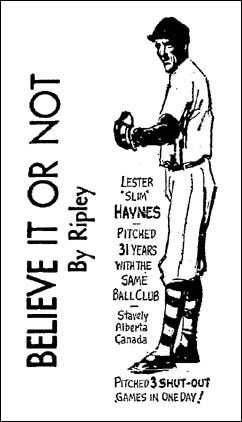 The bane of print reporters - headline writers - led to wider recognition for Haynes in late 1940.
The bane of print reporters - headline writers - led to wider recognition for Haynes in late 1940.
Ripley's Believe It Or Not carried an item on Haynes noting his 31 years with Stavely and his three shutouts in one day. (Ripley's clipping from the Syracuse Herald Journal, November 30, 1940)
Years later, Barry Broadfoot, his his 1973 book, Ten Lost Years, 1929-1939 : Memories of Canadians Who Survived the Depression, picked up and further exaggerated the achievement. Broadfoot not only had the game in the wrong decade (it happened in 1922) but was incorrect in most of his "facts".There was one guy that Stavely brought in and he was a pitcher, a fast-baller, but he had a nice curve too and a curve wasn't seen much at those tourneys, and he pitched a no-hitter the first game, a one-hitter and a two-hitter, and Stavely won the tournament. Naturally. If you don't believe me you can look it up. It was in Robert Ripley's Believe It Or Not. Three great games in one day. This big gink had played pro ball for Seattle or San Francisco and hadn't got the attention he probably through he deserved, but he sure did on the Canadian prairies.
The citation at the Alberta Sports Hall of Fame took it a step further and said one of Haynes' three shutouts in 1922 was a perfect game (which, of course, due to an error, it was not perfect).
Now, Haynes did have a good day that July in 1922. He did hurl a no-hitter in the first game (albeit a seven inning affair) and he did throw a shutout in the money game (holding the opponents to just six hits) but it wasn't up to the Broadfoot or Ripley standard. The headline was likely the problem.
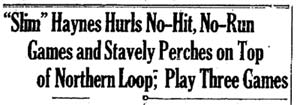
STAVELY, July 27 - On Wednesday Alec Allan and his up-and-coming bunch of ball artists took in the sports day in Barons with blood in their eyes and a fixed determination to oust the Barons outfit from top place in the leaguel and, incidentally they did it, and now repose on the top rung of this ladder of fame.
The program of the day was made up of two league fixtures - Champion v. Barons, and Vulcan v. Stavely, the winners of these draws to play off for the purse. The day was featured by three ball games such as are seldom seen on one occasion, each game resulting in a shut-out.
The opening game between Barons and Champion ended in a 3-0 victory for the latter team. Both Siler for Champion and Pendergast for Barons pitched good ball; but the Barons aggregation lacked their usual pep and support, Williams the Barons centre fielder making a most costly error when he did not move for an easy fly driven out to him. The batteries were: Champion, Siler and Callahan; Barons - Pendergast and Wobeck.
The second game between Vulcan and Stavely resulted in a no-hit no-run game for Slim Haynes, only one of the Vulcan men reaching first on an error of second baseman. Haynes certainly pitched wonderful ball, and had airtight support from his team. Score :
R H E
Vulcan 0 0 0 0 0 0 0 - 0 0 2
Stavely 0 0 0 0 1 2 0 - 3 6 1
The batteries were : Stavely - Haynes and Allan; Vulcan - Carruthers and Recore
Shut Out Champion
With just 5 minutes rest the Stavely boys went into the final game with Champion for first money, shutting out their opponents 4-0. In the fourth innings, with Champion at bat, M. Jenkins, playing deep off second base, tried hard for a fly which bounded off his glove over his head; Malchow in right field coming up fast behind him gathered it in, making a most spectacular catch. Young Anderson, playing deep in centre field, with Champion again at bat in the eighth, made a wonderful throw-in, fielding a fly which had gone over his head and pegging in clear to the home plate, cutting off Glenn. Batteries : Vulcan - Siler and Graham; Stavely - Haynes and Allan.
R H E
Vulcan 0 0 0 0 0 0 0 0 - 0 6 2
Stavely 0 0 1 0 0 0 3 0 - 4 11 2The Stavely nine, by winning their league fixture with Vulcan, and Barons losing theirs with Champion, now heads the league. (The Lethbridge Daily Herald, Saturday, July 29, 1922)
The local paper, the Stavely Advertiser, carried only a short report under the headline, Barons Tournament.
Three shut out games in one afternoon - one of them a no run no hit game - looks like a record: Stavely won two of them and copped all the honors, incidentally stepping into first place in the southern Alberta League. The Stavely-Vulcan game put Haynes name in the coveted roll of honor, when he whiffed 11 batters and did not allow a semblance of a hit. An error by M. Jenkins allowed the only runner in the game to reach first base. While Stavely was winning from Vulcan, Champion was lowering the colors of the pace making Barons tribe, by the shutout route. In the third game for the money Stavely trimmed Champion 4-0." (Friday, July 28, 1922)

Even without the notoriety from the erroneous information (repeated again in the item in the Lethbridge Herald on his departure from Stavely) and the Ripley's presentation, Haynes was an exceptional sportsman and citizen of the community. He died in 1982 at age 94.
" ... Slim Haynes was recognized as the best pitcher in the area. He always has a soft spot in his heart for young players just starting to play. I have had him tell me when I first started to play, 'Stand up there and take a good cut at the ball, as I will never hit you.' If I was lucky enough to get a hit off him he seemed almost as pleased as I was. He left Stavely after many years of playing ball there. he came back for a visit, so the community put on a 'Slim Haynes Day.' They had a ball game slated and invited a number of us old bas-beens from the surrounding towns, who had played with and against him, to participate. My brother, Linden, and I were invited ... The most memorable thing about this day was the fact Slim pitched three of four innings of incredible ball at the young age of 56 years. I have been told that his name is in the 'Baseball Hall of Fame' not only for his athletic ability, but for the interest he took in developing young ball players. A fine man !" Bert Kellicut, Early History of Sports in the Granum Area, Leavings by trail, Granum by rail.
(Thanks to Bill Malchow for the photographs of Haynes, and the Stavely championship team of the 1930s)
In its June 7, 1940 edition, The Stavely Advertiser (subscription $2.00/year, $2.50 for the USA), printed a lengthy story by writer Stew McNeill on Haynes under the heading 31st Year On Mound. [It too repeats the fairy tale of the triple shutout in Barons in 1922.]
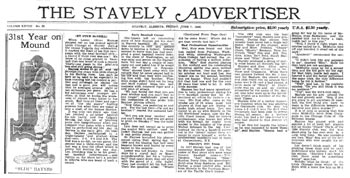 When Lester (Slim) Haynes stepped out on the mound against Little Chicago at Stavely during the recent Victoria day celebration, it marked the start of his 31st campaign with the local baseball club - a record if there ever was one ! We know of no other pitcher in baseball that can boast of such a record. Thirty-one years in the pitcher's box and still going strong !
When Lester (Slim) Haynes stepped out on the mound against Little Chicago at Stavely during the recent Victoria day celebration, it marked the start of his 31st campaign with the local baseball club - a record if there ever was one ! We know of no other pitcher in baseball that can boast of such a record. Thirty-one years in the pitcher's box and still going strong !
Haynes seems to go on and on through the years with little change in his hurling form. Les. isn't as spry as he used to be especially in base running but his control is perfect and although he claims his fast ball is gone, you will notice that he averages around eight or ten strikeouts per game. He has a big advantage over younger pitchers, in that he knows the weakness of almost every hitter in the south. Ball fans sit there and marvel at "the olds man's" hurling prowess but what they see today is only a shell of the former Haynes.
It was only two years ago that Les. pitched a no-hitter against his son Larry, and the Calgary Bronks, but that bit of pitching pales into insignificance when you compare that game with a twirling feat he performed one hot day in Barons in the early '20s. On that day, Haynes participated in a triple-header and pitched three shut-outs, 3-0, 4-0 and 8-0. The first was a no-hit, no-run game, the second was a three-hitter, and the last was a four-hit effort which is pretty fair hurling for one day. Les. considers this to be his greatest baseball achievement - and rightly so, for there isn't a pitcher in Alberta who can boast of such a record.
Old-timers tell an interesting story of how Haynes got his start in Stavely baseball. He came to this country in 1908 and settled down to become a farmer. Nobody seemed to know that Les. had compiled a great baseball record down in the state of Washington, so all was calm and serene on the Haynes' farm 'till one day a couple of men came out and asked Les. if he would pitch for Stavely in Granum. "Slim" shooed them away with the remark that he never played ball in his life and that they were confusing him with his brother. That little dodge didn't hold out for long and back rushed these two ball magnets with renewed vigor and a new plan of attack.
"We just found out that you are your brother and you can"t fool us any longer", maliciously piped up the instigators of this probe into Haynes' private affairs.
"Now listen, you pestering so and so's: For the last time - I'm not my brother !" roared the insenced Lester.
"But you are your brother and you can't deny it, and you are going to pitch on Sunday !" was the calm reply.
Law does not permit us to print the quaint little epithet used by Lester Haynes, but you can gather it was pretty strong.
So Haynes launched his phenomenal career that spring day in 1909 and his blazing fast ball soon became known and feared by every batter in the country.
Lester was not known in those days for a curve ball or smart moundmanship, but for a "cannon ball" that came down that old alley with the speed of a rifle bullet. They just couldn't hit his fast one. Then the question arose : "Where did he come from? Where did he get that terrific fast ball?
Had Professional Opportunities
Well, they soon found out that Les. hailed from Pullman, Wash., and while attending Washington State College, had earned the reputation of having a million dollar arm. "Slim" first started playing in the outfield and his outstanding throwing ability was soon noticed by the coaches. One day the regular pitcher got hurt and Les. was tossed out on the mound, terrified but yet happy. They just couldn't hit that fast one and for the next 30 years they have tried to hit it with little success.
Haynes has had many opportunities to turn professional during his long baseball career but he declined all offers for various reasons. His first offer came at the tender age of 19, when most ball players at that age are trying to make high school team. Les. was slated to go up with Seattle in the old Northwest league, now the Pacific Coast League. Had he turned professional, who knows but what with his fireball, he might have soared to the heights of the great Walter Johnson in the big time. Instead he chose a baseball career out in the "sticks" rather than attempt to carve himself a niche in professional baseball's hall of fame at Cooperstown, N.Y.
Stavely's 1917 Team
In 1917 Stavely had one of her numerous wonder teams. On the roster of that great club were some famous baseball names - Tom Vaughn, "Ace" Meyers, "Slim" Haynes, Percy Otto, the sensational shortstop from Spokane, and Bill Fortier, a great catcher who went from Stavely to the Portland Beavers of the Pacific Coast League
The 1924 club was the best "homebrew team Stavely ever produced. During that season this wonder team never lost a single game. Some of the players were Roy and Marc Jenkins, "Chuck" Clark, "Shorty" Bouzyan, Vern Anderson, "Hap" Rea and Bill Rea, Alex. Allan, Earl Reid, Harry Malchow and "Slim" Haynes.
Stavely produced a string of really good teams all through the '20s.
Haynes and Alex. Allan spent part of the 1921 season up in Bashaw and Craigmyle. While these two players formed the No. 1 battery for Bashaw, the closest score any club could run up against that team was 3-18 - not a bad record. A team mate of "Slim's" at Craigmyle was an up and coming youngster by the name of Vic. Sorrel, who later went up to the American league as a member of the Detroit Tigers.
Haynes tells of a rather humorous incident when he was pitching for Craigmyle club. He won his game 4-2 and it was the first time Craigmyle had been able to defeat Hanna all season. As a battery mate, Les. had a big raw-boned boy who had played in that district all season.
"I let this kid handle the hitters as he was supposed to know them all", said Haynes. "Hanna had a great big boy by the name of McMullin, from Saskatoon, and the catcher told me to throw a high, inside ball to this guy."
"Well, I threw it right where the catcher called for it. McMullin teed off and knocked it clean out of the park."
"Accident !" commented the catcher.
"It didn't look like any accident to me", drawled "Slim". Balls hit that hard are not accidents !
"McMullin came up for a second time and the kid gave me the sign for that high, inside ball again. I heaved it and the batter performed the same trick, the only difference being he hit it farther."
"Well", said Les. to his youthful catcher, "Do you still think it was an accident?"
"Yep", was the kid's only reply.
Haynes put his arm around the lad and gravely said: "Son, if you are going to get anywhere in baseball, the first thing you have to learn is the difference between an accident and plain murder!"
It is of note in passing that this same McMullin went from Craigmyle to the Chicago Cubs of the National league.
Haynes has played with an against a lot of good ball players but he thinks "Chuck" Clark, of the 1924 Stavely club, was the best short-stop he has ever seen in a long, long time. He also considers our own "Hap" Rea one of the best receivers who ever caught his offerings.
Les. doesn't think much of his pitching these days and he can't understand why batters don't hit his onions. "Anytime I can beat a club, there must be something wrong", says Les.
Wonder what he thinks of the Little Chicago team which he let down with a mere five hits on May 24?
